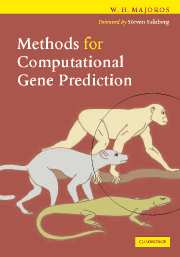Book contents
- Frontmatter
- Contents
- Foreword by Steven Salzberg
- Preface
- Acknowledgements
- 1 Introduction
- 2 Mathematical preliminaries
- 3 Overview of computational gene prediction
- 4 Gene finder evaluation
- 5 A toy exon finder
- 6 Hidden Markov models
- 7 Signal and content sensors
- 8 Generalized hidden Markov models
- 9 Comparative gene finding
- 10 Machine-learning methods
- 11 Tips and tricks
- 12 Advanced topics
- Appendix
- References
- Index
5 - A toy exon finder
Published online by Cambridge University Press: 05 June 2012
- Frontmatter
- Contents
- Foreword by Steven Salzberg
- Preface
- Acknowledgements
- 1 Introduction
- 2 Mathematical preliminaries
- 3 Overview of computational gene prediction
- 4 Gene finder evaluation
- 5 A toy exon finder
- 6 Hidden Markov models
- 7 Signal and content sensors
- 8 Generalized hidden Markov models
- 9 Comparative gene finding
- 10 Machine-learning methods
- 11 Tips and tricks
- 12 Advanced topics
- Appendix
- References
- Index
Summary
In this chapter we will construct a “toy” exon finder for a trivial genome, using mostly ad hoc techniques. While the level of computational sophistication and rigor will contrast starkly with that of later chapters, the purpose here will be to develop some intuition for the more salient aspects of the statistical structure of genes. Source code and sequence files for the examples in this chapter can be obtained through the book's website (see Appendix). The genome that we will be using is that of the fictional organism Genomicus simplicans. We begin by describing some of the features of this toy genome.
The toy genome and its toy genes
The G. simplicans genome has several distinguishing characteristics which make it suitable for illustrating the basic gene-finding problem:
The genome is very dense with genes, with typically no more than 20 bp between successive genes on a chromosome.
The exons within each gene tend to be very small, on the order of 20 bp.
The introns within multi-exon genes tend to be very short, on the order of 20 bp.
The exons incorporate fairly strong codon biases as well as a significant {G,C} bias, and the splice sites and start and stop codons are flanked by positions with fairly strong base composition biases.
The codon usage statistics and base composition biases near splice sites and start and stop codons have been well characterized through extensive experimental work.
Genes occur only on one strand (which we will arbitrarily call the forward strand).
- Type
- Chapter
- Information
- Methods for Computational Gene Prediction , pp. 120 - 135Publisher: Cambridge University PressPrint publication year: 2007



